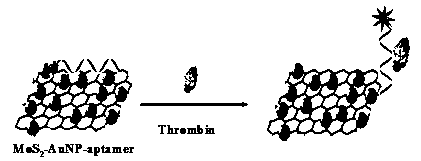A sensor based on molybdenum disulfide and its preparation method and application
A molybdenum disulfide and sensor technology, applied in the field of biomedicine, can solve the problems of preventing detection sensitivity and low cost, and achieve the effects of easy acquisition, low cost, and avoiding false signals
- Summary
- Abstract
- Description
- Claims
- Application Information
AI Technical Summary
Problems solved by technology
Method used
Image
Examples
Embodiment 1
[0030] (1) Preparation of MoS 2 : Prepared according to the method of Eda (Eda, et.al.Photoluminescence fromchemically exfoliated MoS 2 .Nano Letters, 2011, 11, 5111-5116.):
[0031] 3g natural MoS 2 The crystals were immersed in argon-filled 3mL 1.6M n-butyllithium flask for 2 days for lithium intercalation; then, filtered and rinsed with n-hexane to produce Li x MoS 2 Remove impurities. Li x MoS 2 Sonicated in ultrapure water for 1 h, the obtained suspension was centrifuged, rinsed with water, and then filtered with a mixed cellulose ester membrane to obtain a precipitate denatured in an argon-protected glove box at 300 ° C for 1 hour to obtain MoS 2 Soluble in water, ultrasonic 2h standby.
[0032] (2) Preparation of gold nanoparticles: Gold nanoparticles were prepared with reference to the method of Frens (Frens G, Controlled Nucleation for the Regulation of the Particle Size in Monodisperse Gold Suspensions,. Nature PhySci, 1973, 241, 20-22), and the obtained AuNP av...
Embodiment 2
[0041] Steps (1)-(4) are the same as in Example 1.
[0042] (5) Fluorescence quenching: adding nucleotide aptamers to MoS 2- In the aqueous solution of AuNP, Tween80 was added to obtain a mixed solution. After standing at room temperature for 30 minutes, the mixed solution was heated in a water bath at 70°C for 2.5 hours, centrifuged at 10000r for 15 minutes, and then the precipitate was dispersed in 0.1M PBS. That is, the preparation of MoS based on the covalent binding of nucleotide aptamers 2- AuNP sensor for detecting thrombin; MoS 2- AuNPs are capable of quenching the fluorescence of nucleotide aptamer-end-labeled FAMs.
[0043] Among them, MoS 2- The concentration of nucleotide-containing aptamers in the aqueous solution of AuNP was 10 nM, and the MoS contained 2- The concentration of AuNP is 60 μg / mL;
[0044] The MoS added to the nucleotide aptamer 2- The aqueous solution of AuNP is 1 mL, and the volume of Tween80 added is 10 μL; the mass percentage of Tween80 is...
Embodiment 3
[0048] Steps (1)-(4) are the same as in Example 1.
[0049] (5) Fluorescence quenching: adding nucleotide aptamers to MoS 2- In the aqueous solution of AuNP, Tween80 was added to obtain a mixed solution. After standing at room temperature for 30 minutes, the mixed solution was heated in a water bath at 70°C for 2.5 hours, centrifuged at 10000r for 15 minutes, and then the precipitate was dispersed in 0.1M PBS. , which is prepared as a covalently bound MoS based on nucleotide aptamers 2- AuNP sensor for detecting thrombin; MoS 2- AuNPs are capable of quenching the fluorescence of nucleotide aptamer-end-labeled FAMs.
[0050] Among them, MoS 2- The concentration of nucleotide-containing aptamers in the aqueous solution of AuNP was 10 nM, and the MoS contained 2- The concentration of AuNP is 60 μg / mL;
[0051] The MoS added to the nucleotide aptamer 2- The AuNP solution is 1 mL, and the volume of Tween80 added is 10 μL; the mass percentage of Tween80 is 10%;
[0052] The f...
PUM
| Property | Measurement | Unit |
|---|---|---|
| concentration | aaaaa | aaaaa |
| particle size | aaaaa | aaaaa |
| particle size | aaaaa | aaaaa |
Abstract
Description
Claims
Application Information
 Login to View More
Login to View More - R&D
- Intellectual Property
- Life Sciences
- Materials
- Tech Scout
- Unparalleled Data Quality
- Higher Quality Content
- 60% Fewer Hallucinations
Browse by: Latest US Patents, China's latest patents, Technical Efficacy Thesaurus, Application Domain, Technology Topic, Popular Technical Reports.
© 2025 PatSnap. All rights reserved.Legal|Privacy policy|Modern Slavery Act Transparency Statement|Sitemap|About US| Contact US: help@patsnap.com



